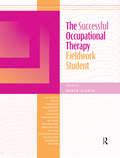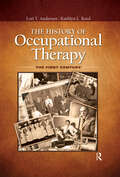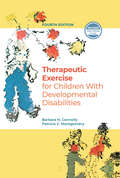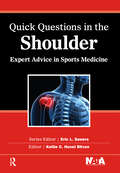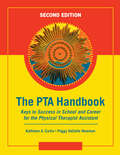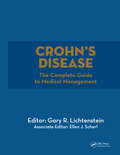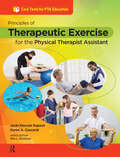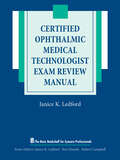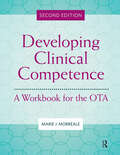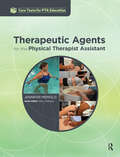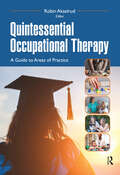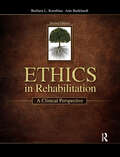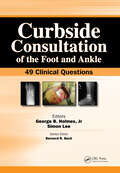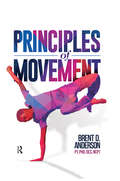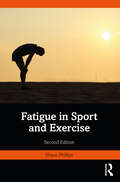- Table View
- List View
The Successful Occupational Therapy Fieldwork Student
by Karen SladykThe Successful Occupational Therapy Fieldwork Student is a stimulating new book that paves the way to the profession of occupational therapy. This book fulfills the needs of all OT and OTA students throughout their entire education by fully preparing them for their fieldwork assignments. This is an imperative learning tool for all students since all curricula include Level I and II fieldwork requirements, ranging from the associate’s level to a master’s program.This complete fieldwork book contains a wide array of topics that guide the reader from the initial planning steps to the completion of successful fieldwork, including how to design fieldwork as a supervisor. It provides students with the opportunity to not only assess various situations, but also utilize their knowledge to demonstrate clinical reasoning. A multitude of activities are included from the first page to the last, designed to groom students for their fieldwork.The Successful Occupational Therapy Fieldwork Student is the ultimate resource for OT/OTA students and the clinicians who educate them, providing a wealth of information while allowing for clinical reasoning to occur. This one-of-a-kind book contains unique features that will prove beneficial to students at varying degrees of education.Features: Each chapter includes activities and assignments for students to complete as they prepare for fieldwork. The text is filled with real-life fieldwork student cases. The text teaches how to prevent problems that can occur, as well as how to fix them when they do.
The History of Occupational Therapy: The First Century
by Kathlyn Reed Lori AndersenTo understand who we are and where we are going,we first need to understand who we were and where we came from.The History of Occupational Therapy: The First Century by Drs. Lori T. Andersen and Kathlyn L. Reed follows a chronological timeline, providing discussions and reflections on the influence of various personalities, politics, legislation and policy, economics, socio-cultural values, technology, and educational factors that led to the progressive maturation of the profession.The History of Occupational Therapy: The First Century includes photographs of pioneers, leaders, and advocates of occupational therapy; pictures of occupational therapy artifacts, including newspaper clippings and historical documents; maps showing historical locations in occupational therapy practice and education; and sidebars that give glimpses into personalities and events.Features: The only historical book on the profession’s first 100 years Scholarly book for teaching, professional, and personal use Included with the text are online supplemental materials for faculty use in the classroom. Features glimpses into occupational therapy personalities The History of Occupational Therapy: The First Century provides all occupational therapy practitioners and occupational therapy students with a historical context of the profession. Generous use of photographs and illustrations create a visually stimulating and scholarly book that provides the historical context of the profession, from the formative stages in the 18th century to the eve of the Centennial Celebration in 2017, as well as a glimpse into the future.“History can tell us that the seeming hardship, the self-doubts of efficacy, the searching for our roots are actually precursors for establishing a new strategic vision and plan that could put us in the forefront of progress.”Robert Bing, President, American Occupational Therapy Association, 1983
Therapeutic Exercise for Children with Developmental Disabilities
by Barbara H. Connolly Patricia MontgomeryTherapeutic Exercise for Children With Developmental Disabilities has been expanded and updated to include everything a student or professional needs to know when working with children with developmental disabilities. Continuing the emphasis on evidence-based practice from the previous editions, this comprehensive Fourth Edition enhances critical thinking and evaluation skills. Throughout the course of the text, Drs. Barbara H. Connolly and Patricia C. Montgomery present case studies of 5 children with various developmental disabilities to bring a problem-solving approach to each individual chapter topic. The case studies include 2 two children with cerebral palsy (GMFCS Levels I and V), a child with myelomeningocele, a child with Down syndrome, and a child with developmental coordination disorder and attention-deficit hyperactivity disorder. Each chapter’s examination, evaluation, and intervention recommendations are accompanied by specific treatment objectives and therapeutic activities, plus a companion website with 17 videos, which contains 90 minutes of content to illustrate concepts. Recent research and clinical recommendations, as well as related references, are also provided in each chapter. This Fourth Edition utilizes the American Physical Therapy Association’s Guide to Physical Therapist Practice 3.0 and the World Health Organization’s International Classification of Functioning, Disability, and Health--Children and Youth as its framework. The focus of the chapters is on children’s participation and empowerment, rather than body function and structure. Examples of new and updated topics in the Fourth Edition: • Practice in the NICU • Early mobility strategies • Communication strategies with children and families • Aquatic therapy • Upper extremity constraint-induced therapy • Mirror therapy • Lower extremity treadmill training With helpful videos, informative figures, and compelling case studies, Therapeutic Exercise for Children With Developmental Disabilities, Fourth Edition is the perfect resource for both students and practicing clinicians.
Quick Questions in the Shoulder: Expert Advice in Sports Medicine (Quick Questions in Sports Medicine)
by Kelly BlivenAre you looking for concise, practical answers to questions that are often left unanswered by traditional sports medicine references? Are you seeking brief, up-to-date, expert advice for common issues that can be encountered when working with athletes?Quick Questions in the Shoulder: Expert Advice in Sports Medicine provides a unique format of concise and to the point responses with clinical application, backed by the latest research on shoulder injuries among athletes. Dr. Kellie C. Huxel Bliven and her contributors present 39 common clinical questions regarding the prevention, assessment, treatment, management, and rehabilitation of the shoulder. Co-published with the National Athletic Trainers’ Association, Quick Questions in the Shoulder: Expert Advice in Sports Medicine provides concise answers to 39 frequently asked clinical questions. Written in a conversational tone, the authors of the individual questions represent a variety of different backgrounds and are experts in their respective field. The variety of questions and brevity of responses will make this a book that is easy to read and reference at the point of care.Some sample sections and questions include: Factors related to shoulder functionHow does the trunk contribute to upper extremity function and injury risk in overhead athletes? Injury diagnosisWhat are the best clinical tests for determining if a patient has scapular dyskinesis and to determine if it is contributing to their shoulder pain and dysfunction? Injury treatment and rehabilitationWhat are the most effective glenohumeral mobilization techniques and when are they most appropriate to use to improve shoulder function and range of motion? The overhead athleteWhat assessments should be used in screening overhead athletes to determine who is at increased risk for injury and what are the most effective injury prevention strategies? Quick Questions in the Shoulder: Expert Advice in Sports Medicine is the perfect at-your-side resource for the athletic trainer, team physician, or sports medicine clinician looking for practical answers to sports-related shoulder injury questions. The concise and conversational tone allows the reader to readily apply the information into their everyday practice.
The PTA Handbook: Keys to Success in School and Career for the Physical Therapist Assistant
by Kathleen A. Curtis Peggy DeCelle NewmanThe updated Second Edition of The PTA Handbook is a unique textbook that serves students from pre-admission into a physical therapist assistant program, through the academic program, up to career entry and practice as a physical therapist assistant.Dr. Kathleen A. Curtis and Peggy DeCelle Newman have updated this Second Edition to reflect current practice standards, including updated core professional documents addressing direction and supervision to align with developments in the physical therapy profession. The PTA Handbook, Second Edition expands on the popular first edition and includes an overview of the physical therapy profession, the physical therapist (PT) – physical therapist assistant (PTA) preferred relationship, evidenced-based practice and information literacy, diversity and cultural proficiency, and planning for life-long learning and leadership development.What is new in the Second Edition:• Includes key documents that guide the provision of physical therapy services and describe the relationship between delivery of care by the PT and PTA• Career development strategies for the PTA, including criteria for Recognition of Advanced Proficiency for the Physical Therapist Assistant and leadership roles in professional, clinical, and community contexts• Case studies and “Putting It Into Practice” exercises are user-friendly, realistic approaches to enhance student learning and comprehension through immediate and meaningful application of the topic being discussed• Written as a strategy-based guide to success for PTA students in meeting the required demands and expectations during a PTA program as well as in practice in the fieldThe PTA Handbook, Second Edition also covers information that will assist advisors and counselors in college and work re-entry programs to provide guidance regarding the physical therapy profession and specifically the differing roles of the PTA and PT. This text will also serve as a key guide for groups of 21st century learners frequently seeking PTA education, including first-generation college students, adult learners, career re-entry, second-language learners, and learners with disabilities.The PTA Handbook: Keys to Success in School and Career for the Physical Therapist Assistant, Second Edition is an essential reference for students, educators, advisors and counselors, and therapy managers who want to maximize the potential for success of the PTA.
Crohn's Disease: The Complete Guide to Medical Management
by Gary R. LichtensteinCrohn’s Disease: The Complete Guide to Medical Management serves as the definitive source for medical management of Crohn’s Disease (CD).Dr. Gary R. Lichtenstein, along with Dr. Ellen J. Scherl, have collaborated with over 60 experts from around the world to provide gastroenterologists and those in training with the necessary information to successfully manage the patient with Crohn’s disease. Sections Include:• Generalo The role of the FDA in drug development; pediatric considerations; disease modifiers; and more• Medicationso Antibiotic use in treatment of CD; oral budesonide; infliximab; novel biological and non biologic therapies for CD; and more• Specific Clinical Scenarioso Management of steroid unresponsive CD; management of enteric fistulae; use of pre- and probiotics; medical management of short bowel syndrome; maintenance therapy of CD; and moreFeatures:• Color images, graphs, and tables• Extensive index that includes cross-referencing to Ulcerative Colitis: The Complete Guide to Medical Management• An appendix on Infliximab treatment• Comprehensive references at the end of each chapterOrganized into an easy-to-reference format, Crohn’s Disease: The Complete Guide to Medical Management threads theory into practice and provides Gastroenterology professionals with the most comprehensive information available on this disease state.The other side of inflammatory bowel disease is covered in Drs. Gary R. Lichtenstein and Ellen J. Scherl’s Ulcerative Colitis: The Complete Guide to Medical Management. All gastroenterologists will find both books to be essential for future practice in the treatment and care of their patients with either Crohn’s disease or ulcerative colitis, as well as in the overall management of those with inflammatory bowel disease.
Principles of Therapeutic Exercise for the Physical Therapist Assistant (Core Texts for PTA Education)
by Jacqueline Kopack Karen CascardiPrinciples of Therapeutic Exercise for the Physical Therapist Assistant is a textbook that provides PTA educators, students, and practicing clinicians with a guide to the application of therapeutic exercise across the continuum of care.Written by 2 seasoned clinicians with more than 40 years of combined PTA education experience, Principles of Therapeutic Exercise for the Physical Therapist Assistant focuses on developing the learner’s ability to create effective therapeutic exercise programs, as well as to safely and appropriately monitor and progress the patient within the physical therapy plan of care. The content is written in a style conducive to a new learner developing comprehension, while still providing adequate depth as well as access to newer research.Included in Principles of Therapeutic Exercise for the Physical Therapist Assistant are:• Indications, contraindications, and red flags associated with various exercise interventions• Documentation tips• Easy-to-follow tables to aid in understanding comprehensive treatment guidelines across the phases of rehabilitation• Eye on the Research sections throughout the text dedicated to current research and evidence-based practicesAlso included with the text are online supplemental materials for faculty use in the classroom, consisting of PowerPoint slides and an Instructor’s Manual (complete with review questions and quizzes).Created specifically to meet the educational needs of PTA students, faculty, and clinicians, Principles of Therapeutic Exercise for the Physical Therapist Assistant is an exceptional, up-to-date guidebook that encompasses the principles of therapeutic science across the entire continuum of care.
Certified Ophthalmic Medical Technologist Exam Review Manual (The Basic Bookshelf for Eyecare Professionals)
by Janice K. LedfordThe Basic Bookshelf for Eyecare Professionals is a series that provides fundamental and advanced material with a clinical approach to clinicians and students. A special effort was made to include information needed for the certification exams in ophthalmic and optometric assisting, low vision, surgical assisting, opticianry, and contact lens examiners.The Certified Ophthalmic Medical Technologist Exam Review Manual is a review book designed for those preparing for the COMT® certification exam. This manual offers some 600 multiple-choice questions on every topic listed in the test criteria, including advanced levels of tonometry, visual fields, color vision, clinical optics, motility, photography, pharmacology, and general medical knowledge. Material that is unique to COMTs, such as microbiology and special instruments & techniques, are also covered. Explanatory answers, often with supporting illustrations and tables as well as the reference from which the material was obtained, are offered to round out your study experience. Suggested study texts are listed, along with an appendix on how to take a practical examination.
The PTA Handbook: Keys to Success in School and Career for the Physical Therapist Assistant
by Kathleen A. Curtis Peggy DeCelle NewmanThe updated Second Edition of The PTA Handbook is a unique textbook that serves students from pre-admission into a physical therapist assistant program, through the academic program, up to career entry and practice as a physical therapist assistant.Dr. Kathleen A. Curtis and Peggy DeCelle Newman have updated this Second Edition to reflect current practice standards, including updated core professional documents addressing direction and supervision to align with developments in the physical therapy profession. The PTA Handbook, Second Edition expands on the popular first edition and includes an overview of the physical therapy profession, the physical therapist (PT) – physical therapist assistant (PTA) preferred relationship, evidenced-based practice and information literacy, diversity and cultural proficiency, and planning for life-long learning and leadership development.What is new in the Second Edition:• Includes key documents that guide the provision of physical therapy services and describe the relationship between delivery of care by the PT and PTA• Career development strategies for the PTA, including criteria for Recognition of Advanced Proficiency for the Physical Therapist Assistant and leadership roles in professional, clinical, and community contexts• Case studies and “Putting It Into Practice” exercises are user-friendly, realistic approaches to enhance student learning and comprehension through immediate and meaningful application of the topic being discussed• Written as a strategy-based guide to success for PTA students in meeting the required demands and expectations during a PTA program as well as in practice in the fieldThe PTA Handbook, Second Edition also covers information that will assist advisors and counselors in college and work re-entry programs to provide guidance regarding the physical therapy profession and specifically the differing roles of the PTA and PT. This text will also serve as a key guide for groups of 21st century learners frequently seeking PTA education, including first-generation college students, adult learners, career re-entry, second-language learners, and learners with disabilities.The PTA Handbook: Keys to Success in School and Career for the Physical Therapist Assistant, Second Edition is an essential reference for students, educators, advisors and counselors, and therapy managers who want to maximize the potential for success of the PTA.
Developing Clinical Competence: A Workbook for the OTA
by Marie MorrealeA newly updated, user-friendly resource for occupational therapy assistant students and new practitioners, Developing Clinical Competence: A Workbook for the OTA, Second Edition assists readers in developing practical problem-solving and “‘real-life”’ skills essential for fieldwork and clinical practice. Maintaining the easy-to-read workbook format from the First Edition, this book is filled with learning activities, worksheets, and detailed answer explanations, as well as expanded chapter content and revised references.Marie J. Morreale breaks down competencies into step-by-step units to allow for independent study. With multiple choice, matching, true/false, and fill-in-the-blanks questions; case studies; vignettes; and experiential activities, this Second Edition presents helpful tips in their most useful format. Guiding the reader through occupational therapy clinical decision making, professional conduct, and meeting standards of care for various practice areas, each chapter is fully independent and can be read in the order most conducive to the reader’s individual learning needs. This text can help readers measure attainment of knowledge and skills when preparing for fieldwork, the national certification exam, or transitioning to entry-level practice.New for the Second Edition: Fundamental topics including effective communication, assessment of client function, safety, supervision, documentation, group process, and department management Additional questions regarding behavioral health and pediatric practice Expanded content for professionalism, ethics, cultural sensitivity, and interventions to support occupations Topics such as wheeled mobility, hand function development, infection control, feeding/eating, wound care basics, quality improvement, and more Added content regarding the American Occupational Therapy Association documents, evidence-informed practice, advocacy, chronic conditions, and new trends Incorporated concepts and principles from the Occupational Therapy Practice Framework: Domain and Process, Fourth Edition Included with the text are online supplemental materials for faculty use in the classroom. Addressing fundamental areas of occupational therapy practice for a wide variety of conditions, situations, and practice settings, Developing Clinical Competence: A Workbook for the OTA, Second Edition includes helpful hints and practical clinical tips to help the OTA implement appropriate interventions and communicate more effectively.
Crohn's Disease: The Complete Guide to Medical Management
by Gary R. LichtensteinCrohn’s Disease: The Complete Guide to Medical Management serves as the definitive source for medical management of Crohn’s Disease (CD).Dr. Gary R. Lichtenstein, along with Dr. Ellen J. Scherl, have collaborated with over 60 experts from around the world to provide gastroenterologists and those in training with the necessary information to successfully manage the patient with Crohn’s disease. Sections Include:• Generalo The role of the FDA in drug development; pediatric considerations; disease modifiers; and more• Medicationso Antibiotic use in treatment of CD; oral budesonide; infliximab; novel biological and non biologic therapies for CD; and more• Specific Clinical Scenarioso Management of steroid unresponsive CD; management of enteric fistulae; use of pre- and probiotics; medical management of short bowel syndrome; maintenance therapy of CD; and moreFeatures:• Color images, graphs, and tables• Extensive index that includes cross-referencing to Ulcerative Colitis: The Complete Guide to Medical Management• An appendix on Infliximab treatment• Comprehensive references at the end of each chapterOrganized into an easy-to-reference format, Crohn’s Disease: The Complete Guide to Medical Management threads theory into practice and provides Gastroenterology professionals with the most comprehensive information available on this disease state.The other side of inflammatory bowel disease is covered in Drs. Gary R. Lichtenstein and Ellen J. Scherl’s Ulcerative Colitis: The Complete Guide to Medical Management. All gastroenterologists will find both books to be essential for future practice in the treatment and care of their patients with either Crohn’s disease or ulcerative colitis, as well as in the overall management of those with inflammatory bowel disease.
Therapeutic Agents for the Physical Therapist Assistant (Core Texts for PTA Education)
by Jennifer MemoloThe first textbook specifically for physical therapist assistant (PTA) students on physical agent modalities, Therapeutic Agents for the Physical Therapist Assistant is a standout resource that will greatly enhance a PTA curriculum.Therapeutic Agents for the Physical Therapist Assistant focuses on the use and execution of each physical agent, covering thermal, sound-energy, mechanical, electrical, and electromagnetic agents. Tables, graphs, review questions, and photos are included for visual reference and lab practice. Clinical tips and case studies are sprinkled throughout each chapter, along with sample documentation and checklists to follow when documenting a therapeutic modality. Topics include: Thermal agents, including thermotherapy and cryotherapy Sound-energy modalities, including therapeutic ultrasound and phonophoresis Mechanical agents, including hydrotherapy, traction, compression, manual therapy, and soft-tissue mobilization Electrical agents, including electrotherapy Electromagnetic agents, including shortwave diathermy, low-level laser therapy, infrared light therapy, and ultraviolet light Included with the text are online supplemental materials for faculty use in the classroom, consisting of an Instructor’s Manual and PowerPoint slides.This textbook is perfect for instructors in PTA programs looking for a text on physical modalities and agents that is geared specifically toward their students. This text will equally hold a valuable place on the shelf as an important reference text for PTA students after they enter the field.
Quintessential Occupational Therapy: A Guide to Areas of Practice
by Robin AkselrudOffering a glimpse into the daily schedule, caseload, and roles of clinicians in more than 15 areas of practice, Quintessential Occupational Therapy: A Guide to Areas of Practice is an essential resource for recent graduates and occupational therapists looking to enter a new area of practice.Each chapter focuses on a different area of practice—from outpatient rehabilitation to home care—and is authored by a team of seasoned clinicians who offer advice, work samples, and tips for those entering that area of practice. Quintessential Occupational Therapy also features experts across states and settings to provide the reader with a holistic view and understanding of the practice area they seek to enter.What’s included in Quintessential Occupational Therapy: Sample forms and documents used in a variety of practice settings Common treatment plans and information on clinical diagnoses in each area of practice Guides for testing and relevant clinical information for each setting Quintessential Occupational Therapy: A Guide to Areas of Practice will equip readers with the knowledge and understanding of a variety of practice settings in occupational therapy and is perfect for recent graduates and practicing clinicians alike.
Principles of Therapeutic Exercise for the Physical Therapist Assistant (Core Texts for PTA Education)
by Jacqueline Kopack Karen CascardiPrinciples of Therapeutic Exercise for the Physical Therapist Assistant is a textbook that provides PTA educators, students, and practicing clinicians with a guide to the application of therapeutic exercise across the continuum of care.Written by 2 seasoned clinicians with more than 40 years of combined PTA education experience, Principles of Therapeutic Exercise for the Physical Therapist Assistant focuses on developing the learner’s ability to create effective therapeutic exercise programs, as well as to safely and appropriately monitor and progress the patient within the physical therapy plan of care. The content is written in a style conducive to a new learner developing comprehension, while still providing adequate depth as well as access to newer research.Included in Principles of Therapeutic Exercise for the Physical Therapist Assistant are:• Indications, contraindications, and red flags associated with various exercise interventions• Documentation tips• Easy-to-follow tables to aid in understanding comprehensive treatment guidelines across the phases of rehabilitation• Eye on the Research sections throughout the text dedicated to current research and evidence-based practicesAlso included with the text are online supplemental materials for faculty use in the classroom, consisting of PowerPoint slides and an Instructor’s Manual (complete with review questions and quizzes).Created specifically to meet the educational needs of PTA students, faculty, and clinicians, Principles of Therapeutic Exercise for the Physical Therapist Assistant is an exceptional, up-to-date guidebook that encompasses the principles of therapeutic science across the entire continuum of care.
Ethics in Rehabilitation: A Clinical Perspective
by Ann Burkhardt Barbara KornblauEthical decision-making is a critical component in the broad spectrum of rehabilitation and health care professions today. Ethics in Rehabilitation: A Clinical Perspective, Second Edition was developed to give health and rehabilitation professionals the knowledge and tools they need to approach and solve the ethical dilemmas that challenge them in everyday practice.Following an introduction to ethical theories and principles, Drs. Kornblau and Burkhardt furnish readers with a brief overview of legal principles that may impact ethical decision making, then examine the relationship between ethical and legal principles that clinicians may encounter. The second section provides readers with an opportunity to apply what they have learned and includes more than 100 ethical dilemmas covering a wide variety of practice-related topics. Further reinforcing the concepts, the final sections consist of ethical dilemma worksheets and a set of additional learning resources to assist in the examination and resolution of ethical dilemmas.Features:• More than 100 sample ethical dilemmas extracted from actual practice experiences • Ethical dilemma worksheets to guide learning and illustrate course of action • Extensive set of appendices including sample laws and regulations • Online access to internet resources of state licensure and related lawsEthics in Rehabilitation: A Clinical Perspective, Second Edition offers readers a practical approach to ethics within a clinical context to allow practitioners, educators, and researchers to raise questions, attempt to answer them, and promote and improve ethical practice in rehabilitation.
Curbside Consultation of the Foot and Ankle: 49 Clinical Questions (Curbside Consultation in Orthopedics)
Are you looking for concise, practical answers to those questions that are often left unanswered by traditional foot and ankle references? Are you seeking brief, evidence-based advice for complicated cases or controversial decisions? Curbside Consultation of the Foot and Ankle: 49 Clinical Questions provides quick answers to the tricky questions most commonly posed during a “curbside consultation” between orthopedic surgeons. Drs. George B. Holmes, Jr. and Simon Lee have designed this unique reference which offers expert advice, preferences, and opinions on tough clinical questions commonly associated with the foot and ankle. The unique Q&A format provides quick access to current information related to the foot and ankle with the simplicity of a conversation between two colleagues. Numerous images, diagrams, and references allow readers to browse large amounts of information in an expedited fashion. Curbside Consultation of the Foot and Ankle: 49 Clinical Questions provides information basic enough for residents while also incorporating expert advice that even high-volume clinicians will appreciate. Practicing orthopedic surgeons, orthopedic residents, foot and ankle specialists, and medical students will benefit from the user-friendly, casual format and the expert advice contained within.Some of the questions that are answered:• When do you do an allograft or autograft talar transplantation graft for a failed osteochondral talar lesion?• How do you treat an athlete with chronic lateral foot overload and peroneal tendonitis with a cavovarus foot?• How do you fix your syndesmotic injuries? Can I use tight-ropes now?• I have a 63 year old patient who had an ankle fracture 20 years ago. They are ready for a major procedure now. Should I perform an ankle arthrodesis or should I refer her out to someone for a total ankle arthroplasty? What are your criteria for a total ankle arthroplasty?• Do I need to use bone graft in foot and ankle surgery, autologous or allograft? What graft should I use?
Principles of Movement
by Brent AndersonFrom the founder of Polestar Pilates, Principles of Movement is a practical resource guide on movement science for movement practitioners, therapists, and anyone looking for a practical and easy approach to assess, facilitate, and enhance movement. With applications in physical therapy, occupational therapy, athletic training, kinesiology, physical education, Pilates training, yoga training, dance education, and more, Principles of Movement is designed to help the movement practitioner improve the quality of their practice by better understanding the integrated model of movement assessment and movement facilitation. The text focuses on how to facilitate the quality of movement—not just the quantity. Author Dr. Brent Anderson draws upon his 30 years of experience in rehabilitation and movement science, showing the strong correlation between motor control and biomechanics, and integrating new work on fascia, pain interpretation, and behavioral elements associated with movement. Principles of Movement is designed to facilitate problem solving and movement enhancement through a deeper understanding of universal movement principles. What’s included in Principles of Movement: • How to harness tools such as breath, mobility, dynamic alignment, control, and coordination to improve movement efficiency and performance, minimize injuries, and increase personal satisfaction through successful movement experiences without pain • Examples, practical applications, and teaching tips for movement practitioners • A guide to critical reasoning that applies the Principles of Movement algorithm to exercise selection and treatment planning • Teaching aids and applications that can be immediately integrated into practice, including verbal, tactile, and imagery cueingPrinciples of Movement provides students and practitioners alike with a framework to evaluate, facilitate, and optimize the quality of movement.
Certified Ophthalmic Medical Technologist Exam Review Manual (The Basic Bookshelf for Eyecare Professionals)
by Janice K. LedfordThe Basic Bookshelf for Eyecare Professionals is a series that provides fundamental and advanced material with a clinical approach to clinicians and students. A special effort was made to include information needed for the certification exams in ophthalmic and optometric assisting, low vision, surgical assisting, opticianry, and contact lens examiners.The Certified Ophthalmic Medical Technologist Exam Review Manual is a review book designed for those preparing for the COMT® certification exam. This manual offers some 600 multiple-choice questions on every topic listed in the test criteria, including advanced levels of tonometry, visual fields, color vision, clinical optics, motility, photography, pharmacology, and general medical knowledge. Material that is unique to COMTs, such as microbiology and special instruments & techniques, are also covered. Explanatory answers, often with supporting illustrations and tables as well as the reference from which the material was obtained, are offered to round out your study experience. Suggested study texts are listed, along with an appendix on how to take a practical examination.
Quick Questions in the Shoulder: Expert Advice in Sports Medicine (Quick Questions in Sports Medicine)
by Kelly BlivenAre you looking for concise, practical answers to questions that are often left unanswered by traditional sports medicine references? Are you seeking brief, up-to-date, expert advice for common issues that can be encountered when working with athletes?Quick Questions in the Shoulder: Expert Advice in Sports Medicine provides a unique format of concise and to the point responses with clinical application, backed by the latest research on shoulder injuries among athletes. Dr. Kellie C. Huxel Bliven and her contributors present 39 common clinical questions regarding the prevention, assessment, treatment, management, and rehabilitation of the shoulder. Co-published with the National Athletic Trainers’ Association, Quick Questions in the Shoulder: Expert Advice in Sports Medicine provides concise answers to 39 frequently asked clinical questions. Written in a conversational tone, the authors of the individual questions represent a variety of different backgrounds and are experts in their respective field. The variety of questions and brevity of responses will make this a book that is easy to read and reference at the point of care.Some sample sections and questions include: Factors related to shoulder functionHow does the trunk contribute to upper extremity function and injury risk in overhead athletes? Injury diagnosisWhat are the best clinical tests for determining if a patient has scapular dyskinesis and to determine if it is contributing to their shoulder pain and dysfunction? Injury treatment and rehabilitationWhat are the most effective glenohumeral mobilization techniques and when are they most appropriate to use to improve shoulder function and range of motion? The overhead athleteWhat assessments should be used in screening overhead athletes to determine who is at increased risk for injury and what are the most effective injury prevention strategies? Quick Questions in the Shoulder: Expert Advice in Sports Medicine is the perfect at-your-side resource for the athletic trainer, team physician, or sports medicine clinician looking for practical answers to sports-related shoulder injury questions. The concise and conversational tone allows the reader to readily apply the information into their everyday practice.
Developing Clinical Competence: A Workbook for the OTA
by Marie MorrealeA newly updated, user-friendly resource for occupational therapy assistant students and new practitioners, Developing Clinical Competence: A Workbook for the OTA, Second Edition assists readers in developing practical problem-solving and “‘real-life”’ skills essential for fieldwork and clinical practice. Maintaining the easy-to-read workbook format from the First Edition, this book is filled with learning activities, worksheets, and detailed answer explanations, as well as expanded chapter content and revised references.Marie J. Morreale breaks down competencies into step-by-step units to allow for independent study. With multiple choice, matching, true/false, and fill-in-the-blanks questions; case studies; vignettes; and experiential activities, this Second Edition presents helpful tips in their most useful format. Guiding the reader through occupational therapy clinical decision making, professional conduct, and meeting standards of care for various practice areas, each chapter is fully independent and can be read in the order most conducive to the reader’s individual learning needs. This text can help readers measure attainment of knowledge and skills when preparing for fieldwork, the national certification exam, or transitioning to entry-level practice.New for the Second Edition: Fundamental topics including effective communication, assessment of client function, safety, supervision, documentation, group process, and department management Additional questions regarding behavioral health and pediatric practice Expanded content for professionalism, ethics, cultural sensitivity, and interventions to support occupations Topics such as wheeled mobility, hand function development, infection control, feeding/eating, wound care basics, quality improvement, and more Added content regarding the American Occupational Therapy Association documents, evidence-informed practice, advocacy, chronic conditions, and new trends Incorporated concepts and principles from the Occupational Therapy Practice Framework: Domain and Process, Fourth Edition Included with the text are online supplemental materials for faculty use in the classroom. Addressing fundamental areas of occupational therapy practice for a wide variety of conditions, situations, and practice settings, Developing Clinical Competence: A Workbook for the OTA, Second Edition includes helpful hints and practical clinical tips to help the OTA implement appropriate interventions and communicate more effectively.
The History of Occupational Therapy: The First Century
by Kathlyn Reed Lori AndersenTo understand who we are and where we are going,we first need to understand who we were and where we came from.The History of Occupational Therapy: The First Century by Drs. Lori T. Andersen and Kathlyn L. Reed follows a chronological timeline, providing discussions and reflections on the influence of various personalities, politics, legislation and policy, economics, socio-cultural values, technology, and educational factors that led to the progressive maturation of the profession.The History of Occupational Therapy: The First Century includes photographs of pioneers, leaders, and advocates of occupational therapy; pictures of occupational therapy artifacts, including newspaper clippings and historical documents; maps showing historical locations in occupational therapy practice and education; and sidebars that give glimpses into personalities and events.Features: The only historical book on the profession’s first 100 years Scholarly book for teaching, professional, and personal use Included with the text are online supplemental materials for faculty use in the classroom. Features glimpses into occupational therapy personalities The History of Occupational Therapy: The First Century provides all occupational therapy practitioners and occupational therapy students with a historical context of the profession. Generous use of photographs and illustrations create a visually stimulating and scholarly book that provides the historical context of the profession, from the formative stages in the 18th century to the eve of the Centennial Celebration in 2017, as well as a glimpse into the future.“History can tell us that the seeming hardship, the self-doubts of efficacy, the searching for our roots are actually precursors for establishing a new strategic vision and plan that could put us in the forefront of progress.”Robert Bing, President, American Occupational Therapy Association, 1983
Fatigue in Sport and Exercise
by Shaun PhillipsFatigue is an important concern for athletes at all levels, recreational sport and exercise participants, athletic coaches, personal trainers, and fitness professionals. The study of fatigue is also important for students of the sport, exercise, and health sciences, as it enables a deeper understanding of fundamental physical function and the limitations behind human performance. There remains considerable debate about the definition of fatigue, what causes it, its impact during different forms of sport and exercise, and the multitude of factors that can influence the nature and severity of fatigue. The vast body of literature in these areas can make it challenging to understand what we know and what we still need to understand about fatigue in sport and exercise. The second edition of this book presents a fully revised and updated overview of the contemporary research evidence into sport and exercise fatigue. The book examines the latest thinking into how we conceptualise fatigue, as well as how we measure it. The fundamental science of fatigue is introduced, focussing predominantly on physiological aspects of energy depletion, metabolic acidosis, environmental challenges, electrolytes and minerals, and the perception of fatigue as it relates to mental fatigue and the central regulation of sport and exercise performance. Each chapter includes real case studies from sport and exercise, as well as useful features to aid learning and understanding such as definitions of key terms, guides to further reading, and discussion questions. Fatigue in Sport and Exercise, Second Edition is an invaluable companion for any degree-level course in sport and exercise science, fitness and training, or strength and conditioning.
The Successful Occupational Therapy Fieldwork Student
by Karen SladykThe Successful Occupational Therapy Fieldwork Student is a stimulating new book that paves the way to the profession of occupational therapy. This book fulfills the needs of all OT and OTA students throughout their entire education by fully preparing them for their fieldwork assignments. This is an imperative learning tool for all students since all curricula include Level I and II fieldwork requirements, ranging from the associate’s level to a master’s program.This complete fieldwork book contains a wide array of topics that guide the reader from the initial planning steps to the completion of successful fieldwork, including how to design fieldwork as a supervisor. It provides students with the opportunity to not only assess various situations, but also utilize their knowledge to demonstrate clinical reasoning. A multitude of activities are included from the first page to the last, designed to groom students for their fieldwork.The Successful Occupational Therapy Fieldwork Student is the ultimate resource for OT/OTA students and the clinicians who educate them, providing a wealth of information while allowing for clinical reasoning to occur. This one-of-a-kind book contains unique features that will prove beneficial to students at varying degrees of education.Features: Each chapter includes activities and assignments for students to complete as they prepare for fieldwork. The text is filled with real-life fieldwork student cases. The text teaches how to prevent problems that can occur, as well as how to fix them when they do.
Ethics in Rehabilitation: A Clinical Perspective
by Ann Burkhardt Barbara KornblauEthical decision-making is a critical component in the broad spectrum of rehabilitation and health care professions today. Ethics in Rehabilitation: A Clinical Perspective, Second Edition was developed to give health and rehabilitation professionals the knowledge and tools they need to approach and solve the ethical dilemmas that challenge them in everyday practice.Following an introduction to ethical theories and principles, Drs. Kornblau and Burkhardt furnish readers with a brief overview of legal principles that may impact ethical decision making, then examine the relationship between ethical and legal principles that clinicians may encounter. The second section provides readers with an opportunity to apply what they have learned and includes more than 100 ethical dilemmas covering a wide variety of practice-related topics. Further reinforcing the concepts, the final sections consist of ethical dilemma worksheets and a set of additional learning resources to assist in the examination and resolution of ethical dilemmas.Features:• More than 100 sample ethical dilemmas extracted from actual practice experiences • Ethical dilemma worksheets to guide learning and illustrate course of action • Extensive set of appendices including sample laws and regulations • Online access to internet resources of state licensure and related lawsEthics in Rehabilitation: A Clinical Perspective, Second Edition offers readers a practical approach to ethics within a clinical context to allow practitioners, educators, and researchers to raise questions, attempt to answer them, and promote and improve ethical practice in rehabilitation.
Therapeutic Exercise for Children with Developmental Disabilities
by Barbara H. Connolly Patricia MontgomeryTherapeutic Exercise for Children With Developmental Disabilities has been expanded and updated to include everything a student or professional needs to know when working with children with developmental disabilities. Continuing the emphasis on evidence-based practice from the previous editions, this comprehensive Fourth Edition enhances critical thinking and evaluation skills. Throughout the course of the text, Drs. Barbara H. Connolly and Patricia C. Montgomery present case studies of 5 children with various developmental disabilities to bring a problem-solving approach to each individual chapter topic. The case studies include 2 two children with cerebral palsy (GMFCS Levels I and V), a child with myelomeningocele, a child with Down syndrome, and a child with developmental coordination disorder and attention-deficit hyperactivity disorder. Each chapter’s examination, evaluation, and intervention recommendations are accompanied by specific treatment objectives and therapeutic activities, plus a companion website with 17 videos, which contains 90 minutes of content to illustrate concepts. Recent research and clinical recommendations, as well as related references, are also provided in each chapter. This Fourth Edition utilizes the American Physical Therapy Association’s Guide to Physical Therapist Practice 3.0 and the World Health Organization’s International Classification of Functioning, Disability, and Health--Children and Youth as its framework. The focus of the chapters is on children’s participation and empowerment, rather than body function and structure. Examples of new and updated topics in the Fourth Edition: • Practice in the NICU • Early mobility strategies • Communication strategies with children and families • Aquatic therapy • Upper extremity constraint-induced therapy • Mirror therapy • Lower extremity treadmill training With helpful videos, informative figures, and compelling case studies, Therapeutic Exercise for Children With Developmental Disabilities, Fourth Edition is the perfect resource for both students and practicing clinicians.
